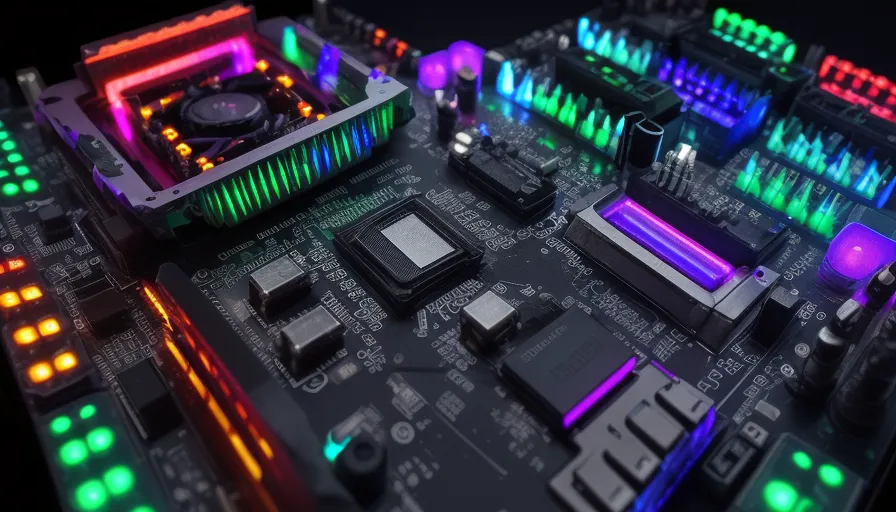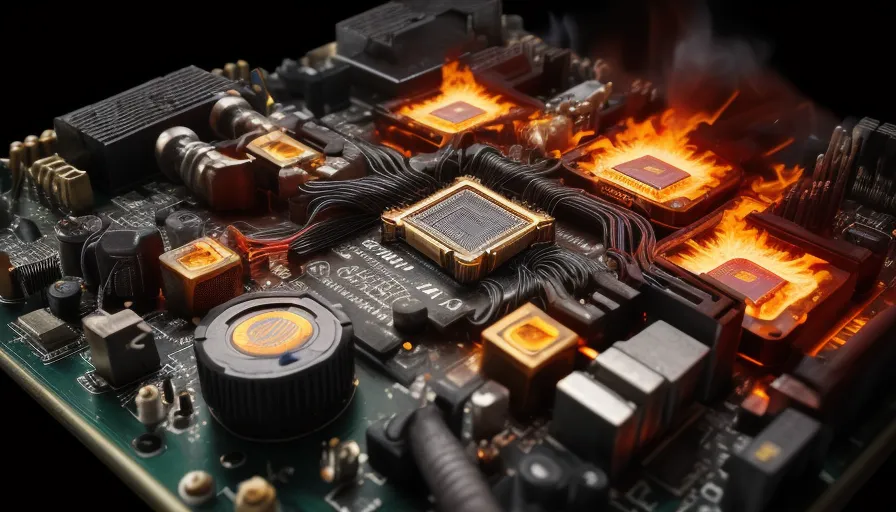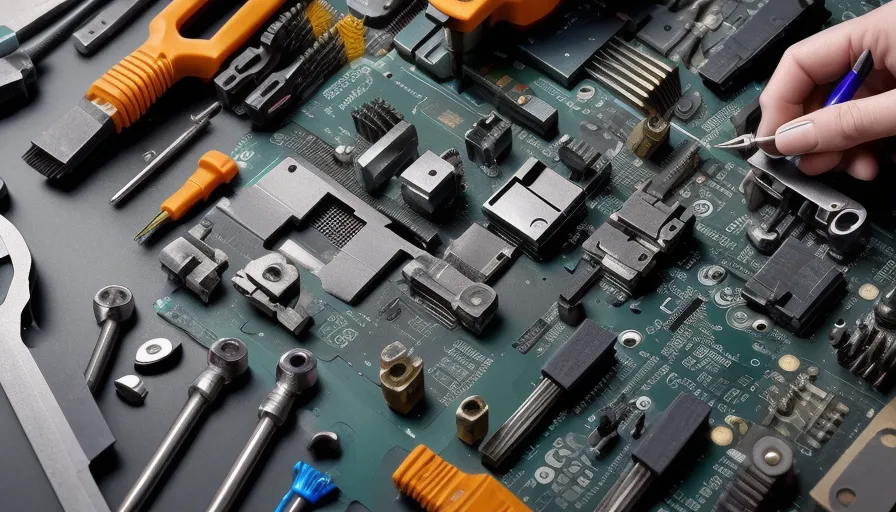Hey! I once had a dead computer and wondered if the motherboard would light up. If it’s completely dead, it won’t light up. But sometimes, if it’s just having issues, you might see a faint light. Hope that helps!
A dead motherboard typically won’t light up at all. If the motherboard is completely non-functional, you should not expect any lights or power. However, faint lights or signs might appear if other components are causing the issue.
In this article, we will discuss whether a dead motherboard will light up, what signs to look for if your motherboard is not working, and how to diagnose and troubleshoot related issues.
Signs of a Dead Motherboard
A dead motherboard can exhibit several symptoms, often leaving users puzzled and frustrated. Here are some common signs:
No Power or Lights
The most apparent sign of a dead motherboard is the absence of power. Pressing the power button does nothing—no fans spin, no lights come on, and the system remains silent.
Unresponsive Hardware Components
If your peripherals, such as the keyboard, mouse, or monitor, don’t respond when you power on the computer, it could indicate a dead motherboard.
Diagnostic Beep Codes
Many motherboards are equipped with speakers that emit beep codes to signal hardware issues. A series of beeps could indicate a problem with the motherboard or other components.
Burning Smell or Visible Damage
A burning smell or visible damage, like scorch marks on the motherboard, is a clear sign of a severe problem. In such cases, the motherboard is likely beyond repair.
Can a Dead Motherboard Light Up?
Now, let’s tackle the core question: Can a dead motherboard still light up? The answer isn’t as straightforward as it might seem.
Definition of a “Dead” Motherboard
A “dead” motherboard generally refers to one that can’t perform its primary functions—like running the CPU, handling memory, or communicating with other hardware components.
Power and Motherboard LEDs
Even if a motherboard is considered dead, some components, like the power supply or LEDs on the motherboard, may still receive power and light up. However, this doesn’t mean the motherboard is functional; it simply means some power is reaching it.
Situations Where a Dead Motherboard Might Still Show Lights
There are cases where a motherboard might still show signs of life, such as the power LED lighting up or the fans spinning, even if it’s effectively dead. This can happen if the power circuitry is still partially functional but the motherboard cannot boot or operate the system.
Why a Dead Motherboard Might Still Light Up
Power Circuit vs. Functional Motherboard
A motherboard consists of multiple circuits, some dedicated to power management and others to the actual functioning of the computer. If the power circuit is intact but other critical areas are damaged, the motherboard might still light up without being operational.
Understanding Partial Failure
Partial failure means that only some parts of the motherboard are damaged. For instance, the power circuit might be working, allowing LEDs to light up, but the CPU socket or memory slots could be damaged, preventing the system from working.
The Role of Capacitors and Power Supply
Capacitors on the motherboard store electrical energy and help regulate power. If these capacitors are functioning, they might allow some LEDs to light up even if the motherboard is otherwise dead. Similarly, the power supply might deliver enough power to light up the LEDs but not enough to run the entire system.
Troubleshooting a Dead Motherboard
If you suspect your motherboard is dead but still seeing lights, it’s crucial to troubleshoot the issue carefully.
Basic Troubleshooting Steps
Start by checking all connections, especially the power cables. Ensure everything is securely plugged in.
Checking Power Supply Connections
Sometimes, a faulty power supply connection can mimic the symptoms of a dead motherboard. Make sure to double-check that all connections are firmly secured.
Testing with a Different Power Supply
If possible, test the motherboard with a different power supply to rule out the possibility of a faulty PSU.
Inspecting for Physical Damage
Look for any visible signs of damage on the motherboard, such as burnt areas, bulging capacitors, or broken components.
Common Causes of Motherboard Failure
Understanding the common causes of motherboard failure can help you prevent future issues.
Power Surges and Electrical Damage
Power surges, often caused by lightning strikes or unstable power sources, can damage the delicate circuits on a motherboard.
Overheating and Thermal Stress
Overheating is a leading cause of motherboard failure. Ensure your system has adequate cooling to prevent thermal stress.
Manufacturing Defects
Sometimes, a motherboard fails due to manufacturing defects. If this is the case, it may fail within the warranty period.
Wear and Tear Over Time
Like all hardware, motherboards can wear out over time. Components degrade, connections weaken, and eventually, the motherboard might fail.
How to Diagnose a Dead Motherboard
Diagnosing a dead motherboard requires patience and the right tools.
Using Diagnostic Tools (e.g., Multimeter)
A multimeter can help you test power levels and continuity on the motherboard to identify dead areas.
Checking POST (Power-On Self-Test)
During startup, the motherboard performs a POST. If it fails, it usually indicates a hardware problem.
Swapping Components (CPU, RAM, GPU)
If possible, swap out the CPU, RAM, and GPU to rule out other hardware issues before concluding the motherboard is dead.
Consulting with a Professional Technician
If you’re not comfortable diagnosing the issue yourself, consult with a professional technician who can run more advanced tests.
Preventing Motherboard Failure
Prevention is always better than cure. Here are a few tips to help maintain your motherboard’s optimal condition.
Importance of Surge Protectors
Using surge protectors can shield your motherboard from electrical damage due to power surges.
Proper Ventilation and Cooling
Ensure your computer case has proper ventilation and cooling to prevent overheating.
Regular Maintenance and Cleaning
Regularly cleaning your computer’s internals can prevent dust buildup, which can cause overheating and short circuits.
Avoiding Overclocking Without Proper Support
Overclocking can push your motherboard beyond its limits. Only overclock if you have proper cooling and a high-quality motherboard designed for it.
What to Do If Your Motherboard Is Dead
If you’ve determined that your motherboard is dead, you have a few options to consider.
Options for Replacement or Repair
You can either replace the motherboard with a new one or attempt to repair it. Replacement is often the more straightforward option, especially if the motherboard is old or severely damaged. However, if the motherboard has a minor issue, such as a blown capacitor, a repair might be possible.
Backing Up Data Before Attempting Repairs
Before you proceed with any repairs or replacement, it’s crucial to back up any important data stored on your computer. Even though the motherboard is dead, your storage drives might still be intact. Remove them from the computer and connect them to another system to back up your files.
Evaluating the Cost of Repair vs. Replacement
Consider the cost of repairing the motherboard versus buying a new one. Repairs can sometimes be as expensive as a replacement, especially if professional service is required. Additionally, newer motherboards often come with updated features and better performance, making a replacement a more attractive option.
Choosing a New Motherboard
If you decide to replace your dead motherboard, here are some factors to consider:
Factors to Consider (Compatibility, Features, Budget)
When choosing a new motherboard, ensure it is compatible with your existing components, such as the CPU, RAM, and GPU. Consider the features you need, such as the number of USB ports, PCIe slots, and support for specific storage types. Your budget will also play a significant role in your decision.
Popular Motherboard Brands and Models
Some of the popular motherboard brands include ASUS, MSI, Gigabyte, and ASRock. Research models that suit your needs and budget, and read reviews to find one that’s reliable and well-suited to your requirements.
Installation Tips for a New Motherboard
When installing a new motherboard, handle all components with care. Use an anti-static wristband to prevent static electricity from damaging sensitive parts. Ensure all connections are secure and double-check everything before powering on your system.
Repairing a Dead Motherboard
If you opt for repair instead of replacement, here’s what you need to know:
Is Motherboard Repair Possible?
Motherboard repair is possible in some cases, especially if the issue is minor, such as a blown capacitor. However, more severe damage, like a fried CPU socket, might not be repairable.
DIY Repair vs. Professional Service
If you’re experienced with electronics, you might attempt a DIY repair. However, for most users, it’s advisable to seek professional help, as repairing a motherboard can be complex and delicate work.
Cost Considerations and Feasibility
Repairing a motherboard can be cost-effective if the issue is minor, but if extensive work is required, the cost might exceed that of a new motherboard. Consider the feasibility and potential risks before deciding on repair.
Is motherboard dead? Only it’s led’s turn on, nothing else and no boot
If only the motherboard’s LEDs turn on but there’s no boot or other signs of activity, it could indicate a few possibilities. The motherboard might be receiving power but could still be faulty, or there might be an issue with other components like the CPU, RAM, or power supply. It’s worth checking all connections and components, and if everything seems in place, you might need to consider replacing the motherboard or seeking professional help.
Will Motherboard Light up if PSU dead?
If the power supply unit (PSU) is dead, the motherboard typically won’t light up. The PSU provides the necessary power for all components, so if it fails, the motherboard won’t receive power and won’t show any lights or signs of activity.
If there is no CPU in the motherboard, will the LED still be on?
If there’s no CPU in the motherboard, the LEDs might still turn on, depending on the motherboard and its power state. However, the system won’t boot or function properly without a CPU, as it’s essential for the motherboard’s operations.
Motherboard Light Is On But No Power Up
If the motherboard light is on but the system won’t power up, it could mean several things: the motherboard might be partially functional but not fully operational, or there could be an issue with other components like the CPU, RAM, or power supply. Checking all connections, testing components, and considering a professional diagnosis might be necessary to pinpoint the problem.
Motherboard lights up but no power?
If the motherboard lights up but there’s no power to boot the system, it could indicate a few issues. The motherboard may be receiving power but could have a problem with other critical components like the CPU, RAM, or power supply. It’s best to check all connections, test each component, and ensure the power supply is functioning correctly.
Identifying Whether Your Motherboard Is Failing or Misconfigured
To identify if your motherboard is failing or misconfigured, follow these steps:
- Check for Power: Ensure the motherboard is receiving power. Look for any lights or signs of activity when you turn on the system. If the motherboard is dead, there will be no power indications.
- Inspect Connections: Verify all cables and components are properly connected. Loose or disconnected cables can cause boot issues.
- Listen for Beeps: If your motherboard has a speaker, listen for beep codes during startup. These codes can indicate specific problems.
- Test Components: Swap out or test individual components (like the CPU, RAM, and power supply) to rule out issues with these parts.
- Clear CMOS: Reset the BIOS settings by clearing the CMOS to resolve any configuration issues. This can help fix any configuration problems.
- Look for Physical Damage: Examine the motherboard for any visible damage, such as burnt areas or damaged capacitors.
- Try a Minimal Setup: Boot with only essential components (CPU, one stick of RAM, and power supply) to see if the system posts. This helps isolate the problem.
If after these steps the motherboard still doesn’t function correctly, it might be failing and may need to be repaired or replaced.
FAQs
Can a dead motherboard cause data loss?
No, a dead motherboard itself doesn’t cause data loss. Your storage drives (HDD/SSD) should still retain your data, which can be accessed by connecting them to another system.
Why does my motherboard light up but not boot?
This could be due to partial motherboard failure, where some circuits are still functional but the motherboard can’t perform its primary functions, like booting the system.
How do I know if my motherboard is dead?
Signs include no power or lights, unresponsive hardware, diagnostic beep codes, or visible damage like burnt components.
Is it worth repairing a dead motherboard?
It depends on the extent of the damage and the cost of repair versus replacement. Minor issues might be repairable, but extensive damage usually warrants a replacement.
How can I prevent my motherboard from dying?
Use surge protectors, ensure proper cooling, regularly maintain and clean your system, and avoid overclocking unless your motherboard is designed for it.
Can my motherboard be dead if it lights up?
Yes, your motherboard can be dead even if it lights up. Lights indicate power but don’t guarantee full functionality. If the system doesn’t boot, further diagnosis is needed.
How do I know if my motherboard is fried?
To determine if your motherboard is fried, check for no power, no boot, or physical damage. If it lights up but fails to start, further testing or replacement may be needed.
Is the motherboard supposed to light up?
Yes, a motherboard often lights up when powered, indicating it’s receiving power. However, lights alone don’t confirm full functionality; other signs like boot issues may suggest problems.
How to check if a motherboard is working or not?
To check if a motherboard is working, power it on and look for signs like LED lights, listen for beep codes, and test with minimal components. No signs often mean issues.
What are the symptoms of a dying motherboard?
Symptoms of a dying motherboard include random crashes, failure to boot, unusual beeping sounds, and hardware not being recognized. If lights are on but there’s no activity, it might be failing.
How do I know if my motherboard is replaced?
To know if your motherboard is replaced, check for a new model number, look for fresh thermal paste or assembly, and confirm with a system that boots and functions correctly.
Can a dead motherboard be repaired?
A dead motherboard can sometimes be repaired, depending on the issue. Common fixes include replacing damaged components or soldering repairs. However, severe damage often requires a full replacement.
How can I check my motherboard?
To check your motherboard, power on the system, observe LED lights, listen for beep codes, test with minimal components, and inspect for visible damage or connection issues.
How can I check my motherboard without opening it?
To check your motherboard without opening it, observe LED indicators, listen for beep codes, and ensure all external connections are secure. Use diagnostic tools or software to monitor system health.
How do I know if my motherboard is no good?
Your motherboard might be faulty if the system fails to boot, shows no signs of power, or displays consistent hardware errors. Listen for beep codes and check for physical damage.
How to check if a CPU or motherboard is faulty?
To check if a CPU or motherboard is faulty, test with minimal components, observe for boot issues or error codes, and swap out parts. If problems persist, one may need replacement.
How to check if motherboard is receiving power?
To check if the motherboard is receiving power, look for LED indicators, listen for fan or component activity, and ensure the power supply is connected and functioning correctly.
Motherboard died suddenly?
If your motherboard died suddenly, check for no power, unusual beeps, or physical damage. Test other components and connections to confirm the issue before considering a replacement.
How to fix a dead motherboard?
To fix a dead motherboard, check all connections, test components individually, and reset the BIOS. If issues persist, inspect for physical damage or consider professional repair or replacement.
How to know if motherboard is damaged in phone?
To check if a phone’s motherboard is damaged, look for power issues, unresponsive screen, or hardware failures. Test with different components and check for visible signs of physical damage.
Will a computer turn on with a bad motherboard?
A computer typically won’t turn on with a bad motherboard. While you might see some lights, the system usually won’t boot or function correctly if the motherboard is faulty.
Conclusion
In summary, a dead motherboard might still light up due to partial functionality in its power circuits. However, this doesn’t mean the motherboard is operational. If you encounter a dead motherboard, careful diagnosis and troubleshooting are essential. Depending on the extent of the damage, you may opt for repair or replacement. Preventative measures, such as using surge protectors and ensuring proper ventilation, can help extend the life of your motherboard.



Leave a Reply